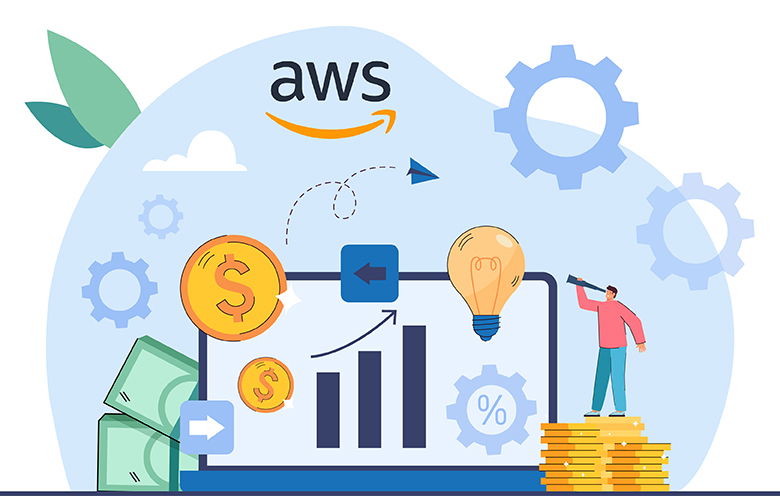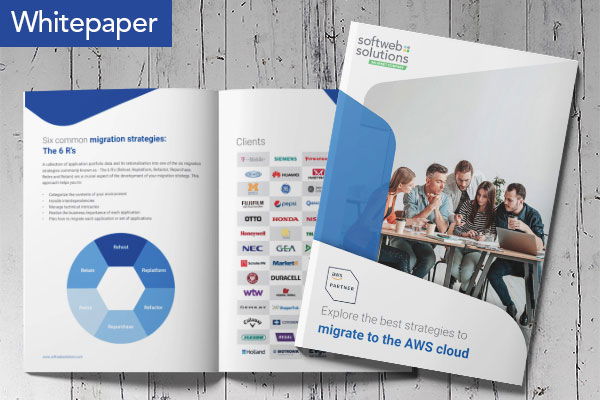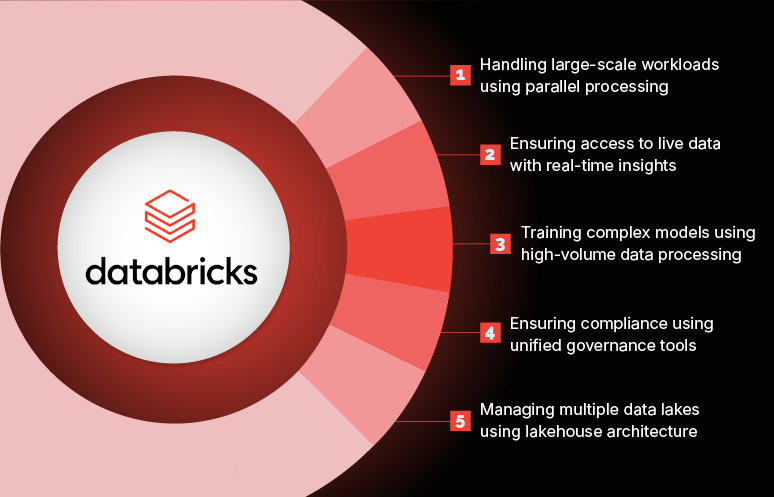Amazon Web Services (AWS) stand as a formidable giant in the dynamic landscape of cloud computing, where agility and scalability are supreme. Organizations worldwide have embraced AWS to power their digital infrastructure, leveraging its vast array of services to drive innovation, enhance customer experiences, and accelerate growth. However, amidst this technological marvel lies a critical challenge- cost management.
As businesses scale up their AWS usage, the associated expenses can spiral out of control, impacting profitability and hindering strategic initiatives. Let’s explore some insights on AWS cost optimization and how to transform your cloud expenditure into a strategic advantage. Whether you’re a startup, a mid-sized enterprise, or a global corporation, these insights will empower you to make informed decisions, streamline operations, and propel your business forward.

AWS cost optimization: Top tips and best practices to reduce your bill
Optimize your AWS cloud investments with cost optimization services & tools. Learn AWS cost optimization best practices & tools to reduce costs, improve performance & avoid unexpected bills.
Here are some key cloud statistics:
- According to the Flexera State of the Cloud report, 82% of 750 cloud decision makers consider managing cloud spend as their primary challenge, ranking security second at 79% and lack of resources/expertise third at 78%.
- Migrating your business to the public cloud can lead to a reduction in total cost of ownership (TCO) of up to 40%, according to Accenture.
Moreover, organizations adopting AWS report significant advantages:
- 27.4% reduction in cost per user
- 67.7% increase in terabytes managed per administrator
- 56.7% decrease in application downtime
- 37.1% reduction in time-to-market for new products and services
5 Common mistakes that increase cloud bill and how to avoid them
1. Unmonitored AWS Instances
Failure to monitor unused AWS instances can lead to unnecessary costs in cloud infrastructure. Neglecting to track idle, aging, or inactive AWS instances results in poor resource utilization, known as cloud sprawl. Organizations face inflated AWS bills due to uncontrolled instances from development testing or shadow IT projects.
How to tackle: To tackle this, a Cloud Center of Excellence (CCoE) can manually track AWS instances or use automated cloud management software, such as AWS Config or AWS Trusted Advisor, to identify and decommission unused instances regularly, optimizing resource utilization and reducing unnecessary expenses.
2. Lack of instance size management
The challenge of improper instance sizing in cloud computing disrupts budgets and performance. Over-provisioning wastes resources and costs, while under-provisioning leads to performance issues. Efficient instance size management involves analyzing workloads, automated scaling, and continuous optimization to align resources with actual needs, ensuring cost-effectiveness and optimal performance.
How to tackle: To tackle instance size management challenges, IT teams or CCoEs customize AWS instance configurations, implement scheduling using AWS Auto Scaling, monitor performance metrics with Amazon CloudWatch for continuous optimization, and leverage AWS offerings like AWS Reserved Instances for cost-effective scaling and predictable billing.
3. Failure to implement a multi-cloud strategy
Failing to implement a multi-cloud strategy means missing out on opportunities to optimize costs, performance, and resilience across various cloud platforms. It limits the ability to compare services and pricing models from different providers like AWS, Azure, and GCP. Without a multi-cloud approach, organizations may face vendor lock-in, higher costs, and reduced flexibility in adapting to changing business needs.
How to tackle: To address the challenge of not implementing a multi-cloud strategy, organizations should prioritize evaluating services and pricing from various providers. Embracing a multi-cloud approach allows for cost optimization, improved performance, and reduced dependency on a single vendor, ensuring flexibility and resilience in cloud deployments.
Suggested: Cloud migration guide: Your strategic path to AWS migration
4. Neglecting orphaned snapshots
Neglecting orphaned snapshots, which are created when instances are terminated without properly managing associated volumes and snapshots, can lead to unnecessary charges in cloud environments. These orphaned volumes and snapshots continue to incur costs even though they are no longer actively used, contributing to wasteful spending and inflated bills. It’s crucial to regularly review and clean up orphaned resources to avoid unnecessary charges and optimize cost management in cloud infrastructures.
How to tackle: To tackle the issue of neglecting orphaned snapshots, implementing backup strategies is crucial. This includes taking snapshots before deleting volumes, which reduces costs by billing only for snapshots at lower rates rather than full volume charges. Additionally, it’s essential to monitor orphaned snapshots regularly and manage them efficiently to avoid unexpected cost surges. This proactive approach, coupled with leveraging AWS services like Amazon EBS Snapshot Lifecycle Manager, ensures optimal cost management and prevents unnecessary expenses in cloud environments.
5. Lack of automation
Not embracing automation for tracking cloud resources hinders efficiency, especially at scale. Manual methods are time-consuming, prone to errors, and often lack real-time insights. Automation streamlines resource management by automatically monitoring, provisioning, and optimizing cloud assets. It reduces human intervention, ensures accuracy, and enables quicker responses to changing workload demands, leading to improved operational efficiency and cost-effectiveness in cloud environments.
How to tackle: Tackling the issue of not embracing automation involves leveraging automated tools and workflows to streamline processes and improve efficiency in cloud operations. Automation enforces best practices, maintains consistent performance standards, and reduces the burden on operations teams by handling repetitive tasks and ensuring accuracy. This enables teams to focus on critical aspects of cloud management, such as optimizing costs, enhancing security, and supporting business innovation, with the assistance of AWS services like AWS Lambda and AWS CloudFormation.

Explore the best strategies to migrate to the AWS cloud
The cloud serves as a tool, not a destination. For insights on leveraging AWS services and cloud migration strategies, explore the whitepaper on migrating to AWS cloud.
The strategic benefits of AWS cost optimization
It is imperative for modern organizations to leverage, cost optimization in AWS since it isn’t merely a tactical exercise – it’s a strategic imperative. As businesses harness the power of Amazon Web Services to drive innovation, enhance customer experiences, and scale their operations, understanding the profound impact of cost optimization becomes paramount.
Let’s delve into the benefits of cost optimization that resonate across organizations, from startups to multinational corporations:
1. Enhanced profitability
At its core, cost optimization is about maximizing value. By meticulously managing AWS expenses, organizations free up capital that can be reinvested strategically. Whether it’s funding R&D initiatives, expanding market reach, or fortifying the balance sheet, every dollar saved contributes to the bottom line. In a competitive business landscape, profitability isn’t a luxury – it’s survival.
2. Agility and scalability
Cost-optimized architectures are inherently agile. They allow businesses to scale up or down seamlessly based on demand fluctuations. Whether it’s handling a sudden surge in user traffic or accommodating seasonal spikes, optimized AWS resources ensure operational flexibility. Agility isn’t just about speed; it’s about adaptability – the ability to pivot swiftly in response to market dynamics.
3. Strategic resource allocation
Cost optimization forces organizations to scrutinize their resource allocation. It prompts questions like: Which workloads are mission-critical? Where can we consolidate? What’s the optimal mix of reserved instances and on-demand capacity? By aligning resources with business priorities, organizations optimize performance, reduce waste, and drive efficiency.
4. Competitive edge
In a digital economy, time-to-market is a critical differentiator. Cost-optimized AWS environments expedite development cycles. Whether it’s launching a new product, rolling out features, or responding to market shifts, streamlined costs translate to faster execution. Organizations that move swiftly gain a competitive edge – edge that can make or break success.
5. Sustainability and corporate responsibility
Cost optimization isn’t just about financial gains; it’s about responsible stewardship. By minimizing resource consumption, organizations contribute to environmental sustainability. Efficiently managed AWS workloads reduce energy consumption, carbon footprint, and e-waste. In an era where conscious consumers and investors prioritize eco-friendly practices, cost optimization aligns with corporate social responsibility.
6. Empowering innovation
Lastly, cost optimization liberates resources for innovation. It fuels experimentation, encourages risk-taking, and fosters a culture of continuous improvement. When teams aren’t bogged down by unnecessary costs, they can focus on ideation, prototyping, and disruptive solutions. Innovation isn’t a luxury – it’s the lifeblood of progress.
AWS cost optimization best practices
- Use the right-sized resources
- Use Spot Instances
- Use Reserved Instances (RIs) and Savings Plans
- Use Auto Scaling
- Use AWS cost management tools
How Softweb Solutions can help organizations with AWS consulting services
Softweb Solutions specializes in crafting personalized AWS cost optimization strategies tailored to your business needs. Our expert team analyzes your AWS environment, identifies cost-saving opportunities, and implements efficient resource management practices, ensuring maximum ROI and performance optimization for your cloud infrastructure.
Ready to optimize your AWS costs? Reach out for personalized cost optimization assistance today!
Navigating the cloud cost horizon
Optimizing cloud costs is crucial, especially with AWS dominance. This blog highlighted common mistakes and provided solutions like addressing unused instances, improper sizing, and lack of automation. The strategic benefits include enhanced profitability, agility, competitive edge, and innovation empowerment. By following best practices like using right-sized resources and AWS tools, organizations can drive long-term success.
So, let’s reduce AWS costs and optimize not just for today, but for the tomorrows we envision. Together, we’ll sculpt a future where innovation thrives, sustainability blooms, and your business yields exponential returns.



